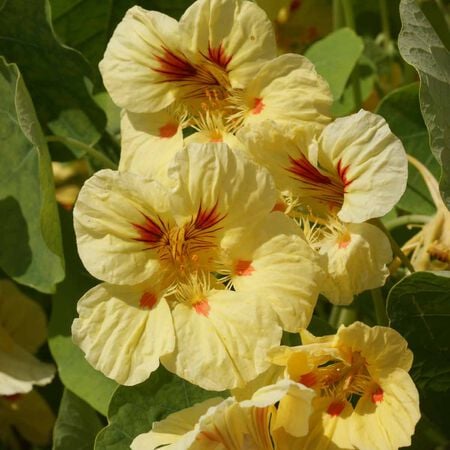Peach Melba, Nasturtium Seeds
Key Attributes
Key Attributes
Product Details
Weight
.025Plant Height
10-15"Botanical Name
Tropaeolum majus nanumSeed Type
SeedAdditional Characteristics
Attracts Pollinators, Attracts Birds, Ground CoverSeeds Per Gram
8Seeds Per Pound
3,600Packet
50 SeedsSow Depth
1"Seeds Per Ounce
225Breed
Open-pollinatedSun
Full SunGrowing Conditions
Container Friendly, Hanging BasketsUses
Edible FoliageLife Cycle
AnnualSow Method
Direct Sow,TransplantCategories
FlowersDays To Maturity (# Days)
55Seeds Per Acre
156 lbsComponents
Growing Instructions
![]() Learning Download: How to Grow Nasturtium
Learning Download: How to Grow Nasturtium
Nasturtium plants have trumpet-shaped blooms with a slightly spicy fragrance. In addition to their beautiful blooms, Nasturtium can be used as edible arrangements and garnishes for culinary dishes.
Before Planting: Nasturtiums like full sun unless grown in hotter climates, which is when they should be grown in an area with partial shade.
Planting: For direct sowing, wait until after all dangers of frost have passed. Plant the seeds an inch deep and space them 10 inches apart.
Watering: Be sure to keep them watered during dry spells.
Fertilizer: It is best not to use fertilizer, as it can make the nasturtium produce more leaves and less blooms.
Days to Maturity: Nasturtiums will bloom from summer to fall.
Harvesting: Pluck the flower, bud or leaf off to be eaten. The flavor will grow more peppery throughout the day so harvest in the morning for a mild flavor and later in the day for a more peppery flavor.
Tips: In addition to being used as border pr planted in a flower garden, Nasturtiums grow well in window boxes or containers.
Shipping Schedule
Our Seed Promise
 "Agriculture and seeds" provide the basis upon which our lives depend. We must protect this foundation as a safe and genetically stable source for future generations. For the benefit of all farmers, gardeners and consumers who want an alternative, we pledge that we do not knowingly buy or sell genetically engineered seeds or plants.
"Agriculture and seeds" provide the basis upon which our lives depend. We must protect this foundation as a safe and genetically stable source for future generations. For the benefit of all farmers, gardeners and consumers who want an alternative, we pledge that we do not knowingly buy or sell genetically engineered seeds or plants.
The mechanical transfer of genetic material outside of natural reproductive methods and between genera, families or kingdoms, poses great biological risks as well as economic, political, and cultural threats. We feel that genetically engineered varieties have been insufficiently tested prior to public release. More research and testing is necessary to further assess the potential risks of genetically engineered seeds. Further, we wish to support agricultural progress that leads to healthier soils, to genetically diverse agricultural ecosystems, and ultimately to healthy people and communities.
To learn more about the "Safe Seed Pledge" please visit www.councilforresponsiblegenetics.org.

